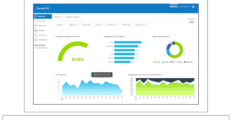The evolution of phones from bulky handheld devices to the smart gadgets we know today has led to the creation and remarkable growth of mobile apps. These apps have become so ubiquitous; not a day goes by that they go unused. In fact, recent studies show the time spent on applications has increased at a CAGR of 25% over the past four years. Plus, with the increasing availability of application development software, we can expect more apps in the future.
In this article, we will discuss key app usage statistics, ranging from consumer behavior and spending on applications to the most popular applications and publishers today. We will also touch on the changes in app usage during the pandemic. With these data, developers can have a better grasp of what app users are looking for while companies can find out how they can leverage these apps to improve customer experience and marketing strategies.

App Usage Statistics Table of Contents:
General App Usage Statistics
Almost everyone uses phone apps. Be it to read the news, book a ride to work, have food delivered, pay bills, listen to music, communicate with friends, and even watch one’s favorite shows, there’s a good chance you’ve used an app today. You may even be using one now as you’re reading this article.
As you’ll see in the statistics below, app usage over the past couple of years has grown, with consumers spending a good chunk of their day on it. In fact, it has surpassed the time spent on live television as of 2020. One factor contributing to this is the sheer variety of app categories, ranging from education and work to entertainment and social media. A large number of smartphone users have also been turning to finance apps and delivery apps, partly because of the pandemic.
- Globally, consumers spent 3.5 trillion hours on their smartphones in 2020. (App Annie, 2021)
- The average American spent 4 hours on mobile device daily in 2020, surpassing the time spent on live TV (3.7 hours). (App Annie, 2021)
- In 2019, consumers spent an average of 3 hours and 40 minutes on their mobile applications. (App Annie, 2020)
- Studies show that the average consumer uses nine apps daily and up to 30 applications every month. (BuildFire, 2021)
- On average, a smartphone user launches apps 2.36 times daily. (Adjust, 2020)
- Session length across all app verticals reached 20.04 minutes in 2020. (Adjust, 2020)
- In Q1 2020, the total data consumption of an average app user is 46.1 exabytes
- In the same year, consumers used 30.5 exabytes on video apps, 4.6 exabytes on social networking, and 1.8 exabytes on social networking. (We Are Social, 2020)

App Usage By Demographics
- Younger smartphone users (18 to 24 years old) tend to have a higher monthly app usage time at 112.6 hours. They are followed by those in the 25-34 age bracket (102.4 hours) and 35-44 age bracket (93.6 hours). Meanwhile, phone users above 45 years of age used apps for 75.6 hours or less every month. (Simform, 2021)
- Gen Zers spent 3.8 hours per month per user on leading non-gaming applications in 2019. (App Annie, 2020)
- In addition, Gen Zers had 150 sessions per app every month. This is 60% more application sessions per user compared to their older cohorts. (App Annie, 2020)
- Across all age brackets, females spend more time on social media per day than males. For instance, females aged 16 to 24 spend 3 hours, 12 minutes compared to males of the same age (2 hours, 37 minutes). (We Are Social, 2020)
- The apps that American Gen Zers are most likely to use are Snapchat, Twitch, and TikTok. Meanwhile, Millennials would lean towards Discord, LinkedIn, and PayPal. (App Annie, 2021)
- In 2020, Gen Zers and Millennials spent 16% and 18% more time on applications than the previous year, respectively. Surprisingly, among Gen Xers and Baby Boomers, the increase in time spent was 30%. (App Annie, 2021)
Source: Simform
App Installation and Churn
- Between Q2 and Q3 of 2020, over two billion mobile applications were released. Of this, 288,776 are games, 168,890 are Educational apps, and 164,881 are Entertainment apps. (Liftoff, 2020)
- The average consumer has around 40 applications on his or her phone. However, 89% of a smartphone user’s time is only split between 18 applications. (Simform, 2021)
- For Millennials, an average of 67 apps are installed on their phones but only 25 are commonly used. (Simform, 2021)
- 25% of applications are only used once after their installation. (Business 2 Community, 2019)
- 71% of consumers who use apps stop within the first three months of downloading them. (BuildFire, 2021)

By App Type
- A study by App Annie showed that Social and Communication apps make up for 50% of the overall app usage time for popular smartphone activities. It is followed by Video and Entertainment (21%), Others (19%), and Games (9%). (App Annie, 2020)
- This is echoed by a more recent survey that showed social media is the app category with the highest average amount of time spent per week at 131 minutes. This is followed by Gaming (116 minutes), Communication (102 minutes), Music (80 minutes), Entertainment (67 minutes), and Retail and ecommerce (65 minutes). (Simform, 2021)
- Consumers spent over 50% more sessions on Entertainment apps in 2019 than two years prior. (App Annie, 2020)
- By 2020, entertainment applications saw a 25% increase in usage. Meanwhile, music apps experienced the same at 21%. (Adjust, 2020)
- 24% of app users say they expect to continue streaming short videos. Twenty-three percent said the same about streaming films and series. Meanwhile, 18% expect a continued increase in social media use. (We Are Social, 2020)
- Casual gaming and sports gaming apps have the highest time spent at 21.19 minutes and 22.77 minutes, respectively. (Adjust, 2020)
- Time spent in sports apps grew by around 30% in 2019. In the same period, the megabytes used on these apps grew by 80%. (App Annie, 2020)
- Across the globe, app users have accessed finance applications like mobile banking and stock management over a trillion times in 2019. (App Annie, 2020)
- Moreover, the average monthly active users of leading FinTech applications increased by 20% in 2019. Banking MAUs, in particular, increased by 15%. (App Annie, 2020)
- In 2020, there was a 45% increase in the time spent on finance apps worldwide. (App Annie, 2021)
- The average smartphone user has 2.5 finance applications on his or her device. (Adjust, 2020)
- The average yearly sessions per user among wallet apps has increased by 52 sessions, which is equivalent to an additional 1 session per user per week. (App Annie, 2020)
- Investment monitoring and trading apps saw a 55% increase in usage in 2020. (App Annie, 2021)
- Meanwhile, the number of shopping app downloads has grown to 5.4 billion between 2018 and 2019. (App Annie, 2020)
- Food and drink app usage also increased by 250% between 2017 and 2019. (App Annie, 2020)
- Consumers spent an average of $2.2 billion on dating applications in 2019. (App Annie, 2020)
Weekly Time Spent on Apps, by Category
(in minutes)
Social: 131
Social
Gaming: 116
Gaming
Communication: 102
Communication
Music: 80
Music
Entertainment: 67
Entertainment
Retail and ecommerce: 65
Retail and ecommerce
Finance: 57
Finance
Mobile browser: 46
Mobile browser
Others: 42
Others
Productivity : 35
Productivity
Source: Simform
Designed byApp User Behavior
- 90% of internet users who use applications say they watch online videos, 72% stream music, and 52% watch vlogs. (We Are Social, 2020)
- 91% of smartphone users say they access their apps at home. Meanwhile, others say they use these applications while in the washroom (83%), while having dinner (73%), or while at work (72%). (Simform, 2021)
- Over half of smartphone users (51%) say they would use a brand’s mobile app if they can get rewards or points through it. (Google, 2019)
- 63% of consumers who use smartphones are more likely to buy from brands with mobile apps that offer relevant product recommendations. (Google, 2019)
Source: Simform
Android and iOS App Usage Statistics
The Google Play Store and the Apple App Store are the two application stores dominating the market today. Android and iOS app usage statistics show that on both platforms, growth was seen in usage and downloads. What’s more, the types of applications being utilized on both platforms are also similar, suggesting that Android and iOS users are not at all different when it comes to user preferences and current app usage.
- Google Play Store offers the largest catalog among all app stores with 3.14 million applications in its catalog. It is followed by the Apple App Store with 2.09 million available applications. (Statista, 2021)
- In 2019, App Store users downloaded 31 billion applications while Google Play Store users downloaded 85 billion. (Sensor Tower, 2021)
- 96.7% of applications on Google play and 92.9% of applications on the Apple App Store are free to download. (42matters, 2021)
- The average price of an app on the Apple App Store is $0.91. (PocketGamer.biz, 2021)
- The majority of the paid apps on the Google Play Store (38,212) cost below $1 as of March 2021. Only 2,396 apps have a price that reaches $9 to $10. (42matters, 2021)
- Games are the most popular Apple App Store category with a 21.53% share of the available apps on the platform. It is followed by Business apps (10.11%), Education apps (8.67%), and Lifestyle apps (8.62%). (PocketGamer.biz, 2021)
- Meanwhile, the least popular Apple App Store category is News (1.81%), Reference apps (1.93%), and Medical apps (1.93%). (PocketGamer.biz, 2021)
- The most popular app categories on the App Store based on the number of downloads are games (2,970 billion), photo and video (665 million), and entertainment (626 million). (Sensor Tower, 2020)
- On the other hand, a similar trend can be seen for the Google Play Store according to app usage statistics for Android. Games have the highest number of downloads at 10.35 billion. However, the second most downloaded app category is tools at 1.5 billion. It is followed by entertainment at 1.2 billion. (Sensor Tower, 2020)
- When it comes to the share of available apps on Google Play Store, the games category tops the list at 13.56%. It is followed by education 9.45% and business at 6.74%. (Appfigures, 2021)

App Usage During the Pandemic
Many industries were negatively affected by the COVID-19 pandemic. However, it seems that the opposite effect happened to the app development industry.
The outbreak seems to have paved the way for a massive increase in app usage and downloads worldwide. More people increased time spent not only on entertainment and mobile gaming apps but also on children’s education and remote work apps. This trend can only signal good things for marketers who are looking to roll out ad campaigns on apps or are launching their own apps. To make the most out of this shift, we highly recommend that you invest in mobile marketing software so you can manage your campaigns as efficiently as possible.
- At the onset of the pandemic in April 2020, the monthly time spent on apps reached over 200 billion hours. (App Annie, 2020)
- Meanwhile, by Q2 2020, the time spent using mobile apps had already increased by 40% year-over-year. (App Annie, 2020)
- The countries with the highest increase in daily mobile hours between 2019 and Q2 2020 are Russia (40%), Canada (39%), and India (37%). (App Annie, 2020)
- Meanwhile, the countries that had minimal increase in daily mobile hours in the same time period are South Korea (5%), Germany (10%), and the United States (10%). (App Annie, 2020)
- In 2020, the countries with the highest daily mobile time are Indonesia (6 hours), India (4.8 hours), Brazil (4.8 hours), and China (4.4 hours). (App Annie, 2020)
- Between March 2 and March 16 of 2020, there was a 1,457% increase in downloads of remote work apps in the US. These are followed by education apps (1,087%), grocery delivery apps (322%), and ride-sharing apps (46%). (Statista, 2021)
- A similar study showed different results, however, stating that the app categories with the highest growth in 2020 are web conferencing (627%), telemedicine (613%), and e-signatures (511%). (Bugsnag, 2020)
- Meanwhile, by July 2020, users report increased use of apps for children’s education (56%), film and series streaming (54%), and short video streaming (51%). Users also report increased use of social media (43%) and messaging apps (42%). (We Are Social, 2020)
- Hours spent on streaming apps increased by 40%. It peaked in Q2 2020 due to the COVID-19 outbreak. (App Annie, 2021)
- TikTok usage per user experienced year-over-year growth of 325%. (App Annie, 2021)
- Time spent per user on YouTube increased six-fold. (App Annie, 2021)
- The weekly sessions spent on food and drink apps grew by 105% in 2020. (App Annie, 2021)
- In Q4 2020, the time spent on business applications increased by 275%. (App Annie, 2021)
Increase in App Usage in July 2020, by Category
Children’s education: 56
Children’s education
%Film and series streaming: 54
Film and series streaming
%Short video streaming: 51
Short video streaming
%Social media: 43
Social media
%Messaging: 42
Messaging
%Music streaming: 37
Music streaming
%General apps: 36
General apps
%Online learning platforms: 31
Online learning platforms
%Source: We Are Social, 2020
Designed byApp Downloads Statistics
The use of applications isn’t the only thing that reached new heights in the past couple of years—the same happened to app downloads. In 2020 and 2021, the number of mobile app downloads has seen a surge across all application stores. Furthermore, it’s showing no sign of stopping, with experts predicting that the industry is poised to grow even further until 2024.
- In 2020, 218 billion applications were downloaded. (TechCrunch, 2021)
- This is higher than the previous year’s total (204 billion). (App Annie, 2021)
- Another study revealed that roughly 31 billion new applications were downloaded in Q1 2020 alone. (Bugsnag, 2020)
- China accounted for a whopping 45% of the total downloads worldwide in 2019. (App Annie, 2020)
- Meanwhile, app users in the US made a total of 12.3 billion downloads, which translates to only 5% of the downloads in the same time frame. (App Annie, 2020)
- Gaming apps comprise 33% of all downloaded mobile applications. (Adjust, 2020)
- Q2 of 2020 saw a surge in mobile app downloads with 37.8 billion apps downloaded from both the Apple App Store and the Google Play Store. (AppleInsider, 2020)
- Experts predict that by 2024, mobile app downloads for the Apple App Store will increase to 45 billion while downloads for Google Play will reach 139 billion. (Sensor Tower, 2021)

Popular Applications and App Publishers
Not all applications are created equal. This is why, like in all industries, consumers tend to prefer one app over the other. Often this is influenced by the prominence of a particular app publisher or the name recall of a certain app.
As you’ll see below, the most popular applications of today include social media networks, such as Facebook and Tiktok, streaming apps like YouTube and Netflix as well as gaming apps like Candy Crush. In addition, we can also see fitness apps and delivery apps gaining popularity partly due to the lockdowns implemented in view of the COVID-19 pandemic.
Popular Applications
- American app users say Facebook is the top app that they cannot do without (17%). It is followed by Instagram (13%), Gmail (9%), and Youtube (8%). (Statista, 2020)
- The top-grossing iPhone mobile gaming app in the US is Roblox with daily revenue of $3,093,504. It is followed by Candy Crush saga at $2,026,652. (Think Gaming, 2021)
- TikTok had one of the highest increases in the time spent per user in 2019 with a 210% boost in global time spent on the platform. (App Annie, 2020)
- Among streaming giants, the ones that are most in-demand are Disney+ with an install bump of 46% and Netflix with a 55% increase in app downloads. (Adjust, 2020)
- The Peloton fitness app was downloaded five times more in March 2020 compared to the month prior. (Adjust, 2020)
- Doordash received the most user growth in 2020 with 150,000 new members using the platform. (Adjust, 2020)
Source: Statista, 2020
Popular Publishers
- Roblox Corporation has the highest revenue among iPhone gaming app publishers in the US generating $20.56 million as of January 2021. It’s followed by King at $12.97 million, Playrix at $12.77 million, Niantic, Inc. at $10.7 million, and Supercell at $10.38 million. (Airnow, 2021)
- King has the highest revenue among gaming app publishers on Google Play Store with a yield of $4.98 million in 2021. At a close second to it is Scopely at $4.78 million, followed by IGG.COM ($4.59 million) and Zynga ($4.39 million). (Airnow, 2021)
- Lion Studios tops Google Play Store gaming app publishers with 8.41 million downloads in 2021. It is followed by VOODOO (5.9 million) and Supersonic Studios LTD (5.86 million). (Airnow, 2021)
- When it comes to the total time spent on apps, Alphabet Inc. takes the largest share among mobile app publishers at 25.6%. It is followed by Facebook at 17% and Samsung Group at 5.9%. (Verto Analytics, 2019)
- In 2019, the leading mobile app publishers in the United States in terms of audience size are Alphabet Inc. (185 million), Facebook, Inc. (176.02 million), and Amazon (158.91 million). (Verto Analytics, 2019)
- The same publishers lead in terms of reach as well. Ninety-eight percent of mobile audiences accessed Alphabet Inc’s apps, 93.5% accessed Facebook, Inc.’s apps, and 84.4% accessed Amazon.com, Inc.’s apps. (Verto Analytics, 2019)

Consumer Spending on Apps
Mobile app usage statistics for 2021 show that in-app purchases are still high despite the initial drop in spending due to the COVID-19 outbreak. This can only mean that consumers are now more willing to spend money on mobile apps compared to previous years. One contributing factor is the shift to home-based work and study setups during the pandemic. Plus, aside from purchasing apps needed for school and work, more individuals have also increased spending on mobile gaming and entertainment since the pandemic hit.
- Smartphone users spent $143 billion on applications, primarily due to the increased migration to mobile. (App Annie, 2021)
- The global spending on in-app purchases across iOS and Google Play hit a whopping $32 billion in Q1 2021 alone. (App Annie, 2021)
- In 2020, consumers spent $72 billion on mobile apps in the App Store and $39 billion on Google Play Store. (Sensor Tower, 2021)
- Overall, consumers spent $49.6 billion on mobile applications in Q4 2020. (DataReportal, 2021)
- Meanwhile, the average spending on apps per smartphone reached $10.6 in the last quarter of 2020. (DataReportal, 2021)
- American consumer spending on non-gaming applications is highest for iOS subscription-based apps (77%). Meanwhile, the spending share for the same app type for Google Play is only 19%. (App Annie, 2021)
- Health and fitness apps experienced a 30% year-over-year growth in consumer spending, which equates to $2 billion. (App Annie, 2021)
- During Christmas 2020, US consumers spent a total of $295.6 million on mobile gaming applications and $112 million on non-game applications. (Sensor Tower, 2020)
- According to projections, by 2025, consumers will spend up to $185 billion on mobile apps in the App Store and $85 billion on apps in the Google Play Store. (Sensor Tower, 2021)
- In line with this, experts predict that mobile apps will generate over $935 billion in revenues by 2023. This will mostly come from paid downloads and in-app advertising. (iResearch, 2021)
Source: DataReportal, AppAnnie
The Future of App Usage is Bright
Smartphones are getting smarter so there is no doubt that apps will follow closely in their steps. App developers will surely take advantage of the new functionalities these devices have to offer and provide consumers with better apps that will make our daily lives more convenient.
In fact, trends in the mobile application industry predict that phones are poised to serve as smart hubs of IoT-enabled devices in the near future. After all, with the expansion of 5G networks and the increasing prevalence of artificial intelligence, augmented reality and virtual reality, as well as predictive analytics, doing so has become easier than ever.
However, while most of these advancements are currently being studied or already underway, it is important to keep in mind that this industry can be volatile. As such, we highly recommend that you stay up-to-date on the latest apps statistics to understand how consumers interact with them as well as how you can leverage these for your business.
Key Insights
- Global Mobile Usage: In 2020, consumers worldwide spent a staggering 3.5 trillion hours on their smartphones, reflecting a significant increase in mobile app engagement.
- Average Usage Time: The average American spent 4 hours daily on mobile devices in 2020, surpassing the time spent on live television.
- App Categories: Social and communication apps account for 50% of the overall app usage time, followed by video and entertainment apps at 21%.
- Demographic Differences: Younger smartphone users (18-24 years old) have the highest monthly app usage time, averaging 112.6 hours, while users above 45 years spend 75.6 hours or less.
- Pandemic Impact: The COVID-19 pandemic led to a massive increase in app usage and downloads, with remote work, education, and grocery delivery apps seeing the highest growth.
- Consumer Spending: In 2020, consumers spent $72 billion on the App Store and $39 billion on the Google Play Store, with projections indicating continued growth in app-related expenditures.
- App Retention and Churn: Despite the high number of app downloads, 71% of consumers stop using apps within the first three months of downloading them.
FAQ
- What is the average daily time spent on mobile apps by users? The average American spent 4 hours daily on mobile devices in 2020, surpassing the time spent on live television.
- Which app categories see the highest usage? Social and communication apps make up 50% of the overall app usage time, followed by video and entertainment apps at 21%.
- How has the COVID-19 pandemic affected app usage? The pandemic led to a significant increase in app usage, especially for remote work, education, and grocery delivery apps. For instance, there was a 1,457% increase in downloads of remote work apps in the US between March 2 and March 16, 2020.
- What are the most popular apps among different age groups? Gen Zers are most likely to use Snapchat, Twitch, and TikTok, while Millennials prefer Discord, LinkedIn, and PayPal.
- How much time do younger users spend on apps compared to older users? Younger users (18-24 years old) spend an average of 112.6 hours monthly on apps, whereas users above 45 years old spend 75.6 hours or less.
- What is the trend in consumer spending on mobile apps? Consumer spending on mobile apps is increasing, with a total of $143 billion spent in 2020. Projections indicate that spending will reach up to $185 billion on the App Store and $85 billion on Google Play by 2025.
- What is the retention rate of mobile apps? The retention rate of mobile apps is low, with 71% of consumers stopping the use of apps within the first three months of downloading them.
- Which countries saw the highest increase in mobile app usage during the pandemic? Russia, Canada, and India saw the highest increase in daily mobile hours between 2019 and Q2 2020, with increases of 40%, 39%, and 37%, respectively.
- How does app usage vary by gender? Across all age brackets, females spend more time on social media per day than males. For example, females aged 16 to 24 spend 3 hours and 12 minutes compared to males of the same age who spend 2 hours and 37 minutes.
- What are the predictions for the future of app usage? The future of app usage is bright, with expectations of apps becoming smart hubs for IoT-enabled devices, driven by advancements in 5G, artificial intelligence, augmented reality, virtual reality, and predictive analytics.
References:
- 42matters (2021). Paid app price distribution in the Google Play store as of March 2021. Retrieved from Statista
- 42matters (2021, March). Distribution of free and paid apps in the Apple App Store and Google Play as of March 2021. Retrieved from Statista
- Adjust (2020). Adjust Global App Trends 2020. Retrieved from Adjust
- Airnow (2021). Leading iPhone gaming app publishers in the United States in January 2021, by revenue. Retrieved from Statista
- Airnow (2021). Leading gaming app publishers in the Google Play Store in the United States in April 2021, by number of downloads. Retrieved from Statista
- Airnow (2021). Leading gaming app publishers in the Google Play Store in the United States in April 2021, by revenue. Retrieved from Statista
- AppleInsider (2020, October). Combined global Apple App Store and Google Play app downloads from 1st quarter 2015 to 3rd quarter 2020 (in billions). Retrieved from Statista
- Appfigures (2021). Most popular Google Play app categories as of 4th quarter 2020, by share of available apps. Retrieved from Statista
- App Annie (2020). State of Mobile 2020. Retrieved from App Annie
- App Annie (2021). State of Mobile 2021. Retrieved from App Annie
- App Annie (2021). Number of mobile app downloads worldwide from 2016 to 2020. Retrieved from Statista
- Armstrong, M. (2020). The Apps Americans Can’t Live Without. Retrieved from Statista
- Bugsnag (2020). Software Bugs Don’t Shelter in Place: What app usage and error data reveal during COVID-19. Retrieved from Bugsnag
- BuildFire (2021). Mobile App Download and Usage Statistics (2021). Retrieved from BuildFire
- Business 2 Community (2019). Percentage of mobile apps that have been used only once from 2010 to 2019. Retrieved from Statista
- DataReportal (2021). The total value of global consumer spend on mobile apps as of 4th quarter 2020. Retrieved from Statista
- DataReportal (2021). Average consumer spend on mobile apps per smartphone as of 4th quarter 2020. Retrieved from Statista
- Google (2019). Google Ipsos U.S. Playbook Omnibus 2019. Retrieved from Google
- iResearch (2021). Worldwide mobile app revenues in 2014 to 2023. Retrieved from Statista
- Kemp, S. (2020). Digital 2020. Retrieved from We Are Social
- Kristianto, D. (2021). Consumers Spent $32 Billion on Apps in Q1 2021— the Biggest Quarter Since Records Began. Retrieved from App Annie
- Kristianto, D. (2020). Mobile App Usage Surged 40% During COVID-19 Pandemic. Retrieved from App Annie
- Liftoff (2020). Number of apps released worldwide between 3rd quarter 2019 and 2nd quarter 2020, by category. Retrieved from Statista
- Perez, S. (2021, January 13). App stores saw record 218 billion downloads in 2020, consumer spend of $143 billion. Retrieved from TechCrunch
- PocketGamer.biz (2021, March). Average prices for apps in the Apple App Store as of March 2021 (in U.S. dollars). Retrieved from Statista
- PocketGamer.biz (2021, March). Most popular Apple App Store categories in March 2021, by share of available apps. Retrieved from Statista
- Sensor Tower (2020, December). Consumer spending on mobile apps on Christmas worldwide in 2019 and 2020. Retrieved from Statista
- Sensor Tower (2021, February). Mobile app consumer spending worldwide from 2020 to 2025, by store. Retrieved from Statista
- Sensor Tower (2020, April). Mobile app downloads worldwide from 2018 to 2024, by store. Retrieved from Statista
- Sensor Tower (2020). Most popular Apple App Store categories from 1st quarter 2016 to 1st quarter 2020, by number of downloads (in millions). Retrieved from Statista
- Sensor Tower (2020). Q1 2020 Data Digest: Offering Expert Analysis on the Latest Mobile Trends. Retrieved from Sensor Tower
- Shah, H. (2021). App Usage Statistics 2021 that’ll Surprise You. Retrieved from Simform
- Statista (2021). Coronavirus impact on U.S. app downloads as of March 2020, by category. Retrieved from Statista
- Statista (2021, January). Number of apps available in leading app stores as of 4th quarter 2020. Retrieved from Statista
- Sydow, L. (2020). How COVID-19 Has Changed Consumer Behavior on Mobile Forever. Retrieved from App Annie
- Think Gaming (2021, March). Top grossing iPhone mobile gaming apps in the United States as of March 2021, ranked by daily revenue. Retrieved from Statista
- Verto Analytics (2019, November). Leading mobile app publishers in the United States as of September 2019, by share of total app time spent. Retrieved from Statista
- Verto Analytics (2019, November). Leading mobile app publishers in the United States as of September 2019, based on audience size. Retrieved from Statista
- Verto Analytics (2019, November). Leading mobile app publishers in the United States as of September 2019, based on reach. Retrieved from Statista






















Leave a comment!